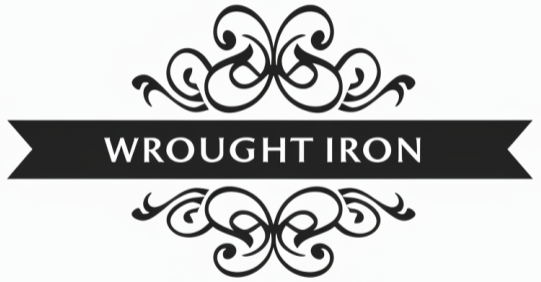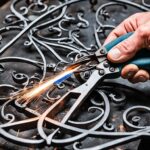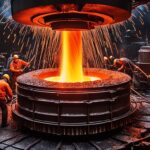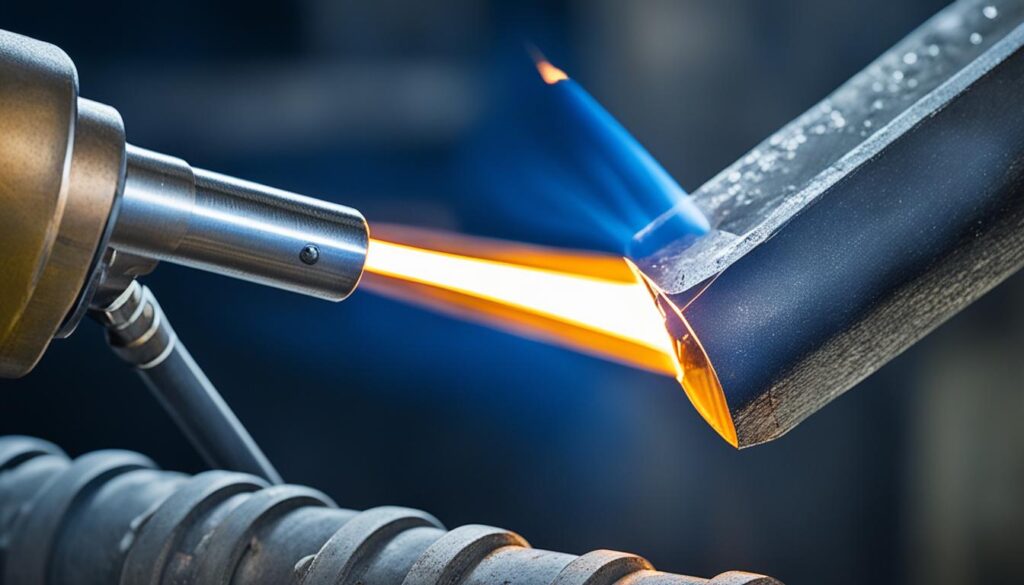
Picture yourself in front of the Palm House at Kew Gardens, admiring the beautiful wrought ironwork. These pieces, from the late 1700s and early 1800s, need careful handling. They often require welding wrought iron to mild steel to keep them looking great1. This challenge of welding different metals, like wrought iron to mild steel, combines tradition with new techniques. It’s about linking our past with our future, keeping these historic buildings safe for years to come.
Even with modern methods, welding wrought iron to mild steel is still tricky. The iron’s silica content can affect the weld’s success. So, it’s crucial to prepare well and use top-notch filler metals1. These steps help make sure each weld is strong and true to the original materials.
Key Takeaways
- Welding wrought iron to mild steel is both a traditional and innovative practice.
- Modern wrought iron, usually low carbon AISI steel, can be successfully joined to mild steel1.
- It requires meticulous preparation and high-quality deoxidized filler metals1.
- The unpredictable nature of wrought iron’s silica inclusions means each weld needs expert attention1.
- Effective welding of these dissimilar metals preserves historical architecture for future generations.
Understanding the Metallurgical Characteristics of Wrought Iron and Mild Steel
Welding wrought iron to mild steel needs a good grasp of their unique properties for top-notch welds. Both materials have their own set of challenges and benefits for welding.
Chemical Composition
Wrought iron is mostly iron with less than 0.05% carbon and about 99.4% pure iron. It also has up to 2% fibrous slag inclusions2. These slag inclusions affect how wrought iron welds. Mild steel, or low-carbon steel, has a balanced chemical makeup. It’s tough, flexible, and not hard to make stronger by heating and quenching2. It’s also resistant to corrosion and versatile for welding.
Structural Properties
The structure of wrought iron and mild steel is quite different, impacting how well they weld together. Wrought iron’s unevenness and slag threads make deep, consistent welds hard3. TIG welding is best for fixing wrought iron because it controls the weld puddle well3. MIG welding doesn’t work as well on wrought iron because of its inconsistent nature3.
Mild steel, however, has predictable properties that make welding easier2. It’s easy to shape and bend, making it great for various welding methods. Stick welding is especially good for mild steel, offering strong welds with good penetration3. Choosing the right welding materials and techniques is key for quality welds.
Knowing the differences between wrought iron and mild steel is vital for picking the best welding methods and materials. This ensures strong and good-looking welds.
Common Challenges When Welding Dissimilar Metals
Welding wrought iron to mild steel is tricky. It requires matching their properties, handling different melting points, and avoiding cracks. Welders need to overcome these hurdles for strong welds.
Metallurgical Compatibility
Iron to steel welding faces a big challenge in metallurgical compatibility. Wrought iron and mild steel have different chemical makeups. This leads to issues in creating a solid weld joint. Wrought iron often has slag that can weaken the weld. Using special filler metals can help solve this4.
It’s also key to manage the compounds that form between the metals. These compounds greatly affect the weld’s strength and durability5.
Different Melt Temperatures
Mild steel melts at a lower temperature than wrought iron. This makes welding them together hard. To weld them well, methods like MIG or TIG welding are best. They help control the heat and avoid a fast cool-down6.
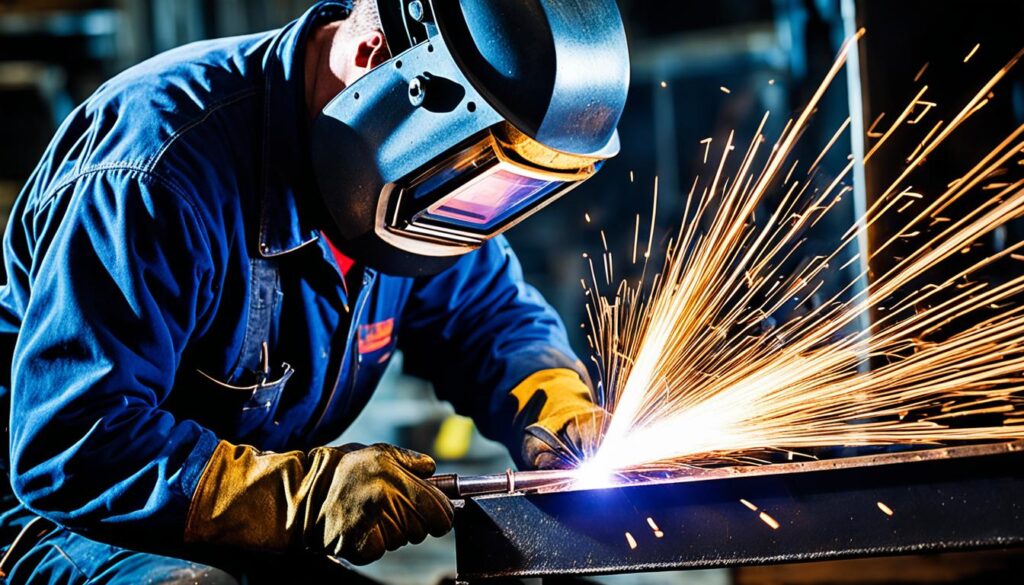
Potential for Cracking
Cracking is a big problem when welding wrought iron to mild steel. Contaminants in the metal can cause cracks. Using certain materials, like 309 or aluminum bronze, can also lead to cracking4.
To avoid this, preheat the materials and cool them slowly. This reduces stress and makes the weld more stable4. Welding wrought iron often uses lower-temperature methods like silver soldering. This lowers the risk of cracking4.
Can You Weld Wrought Iron to Mild Steel?
Yes, you can weld wrought iron to mild steel with the right techniques. Manual Metal Arc (MMA) or Shielded Metal Arc Welding (SMAW) using certain electrodes works well. These methods help manage the high oxygen in wrought iron to avoid weld problems. Also, controlling the electrode size and using low current improves the weld quality.
Metal Inert Gas (MAG) welding, or Gas Metal Arc Welding (GMAW), is another good choice for joining iron to steel. This method uses filler wires that help balance the high oxygen in wrought iron. But, it’s important to weld carefully to avoid slag inclusions.
To weld these metals successfully, you need to understand their makeup. Wrought iron is a type of low carbon steel with less carbon and sulfur. Cleaning the area well before welding is key to a strong bond.
Wrought iron’s makeup makes welding easier, but you still need to be careful. Avoid welding too deeply to prevent slag inclusions. Using specific techniques like stringer beads and controlled cooling helps reduce stress and improve the weld.
Using the right welding methods is essential. It’s a good idea to test welds when combining steel with wrought iron. This ensures the welds are strong and reliable. Following recommended techniques and standards is crucial for success.
Welding Techniques for Joining Wrought Iron and Mild Steel
Welding wrought iron to mild steel needs the right techniques and filler materials. Wrought iron’s unique properties and chemical variations make special techniques necessary for strong welds. Knowing the best methods can greatly improve your results with these different metals.
Manual Metal Arc Welding (MMA or SMAW)
Manual Metal Arc Welding (MMA or SMAW) is a popular choice for its ease and effectiveness. When welding wrought iron to mild steel, rutile-coated electrodes help control the weld pool and reduce impurities. Since wrought iron can only be forge welded, picking the right electrode is key for a good weld7. Make sure to clean and peen the weld while it cools to keep it clean7.
Metal Inert Gas Welding (MAG or GMAW)
Metal Inert Gas Welding (MAG or GMAW) is great for clean welds and is easy to use. An expert in ornamental ironwork might suggest ER-70 wire with a 75/25 argon/CO2 mix for MIG welding8. If you can’t forge weld wrought iron, you can use bronze welding with oxy-acetylene for repairs7. Using anti-spatter spray with MIG welding cuts down on clean-up time, making it a smart choice8.
Choosing the Right Filler Material
Choosing the right filler material is crucial, especially with wrought iron’s high oxygen content. The Welding Institute suggests using highly deoxidized filler metal for welding old wrought iron1. The type of wrought iron and its chemical makeup can affect weldability. So, it’s important to pick a filler material that works well with both wrought iron and mild steel1. A detailed check of the wrought iron’s oxides and impurities is needed before starting the weld1.
Following these tips and recommendations can improve the quality and strength of your welds when joining wrought iron to mild steel. The right welding techniques and filler materials, along with proper heating before and after welding, are key to successful dissimilar metal welding.
FAQ
Can you weld wrought iron to mild steel?
What are the challenges of welding wrought iron to mild steel?
Why is metallurgical compatibility important in welding wrought iron and mild steel?
How do different melt temperatures affect welding wrought iron to mild steel?
What potential for cracking should be considered when welding wrought iron and mild steel?
What are the recommended welding techniques for joining wrought iron and mild steel?
Which filler materials are best for welding wrought iron to mild steel?
What role do heat treatments play in welding wrought iron to mild steel?
Why is expert consultation important for welding wrought iron to mild steel?
Source Links
- Welding Steel to Wrought Iron – https://app.aws.org/forum/topic_show.pl?tid=25339
- Wrought iron – https://en.wikipedia.org/wiki/Wrought_iron
- Welding Wrought Iron? – https://www.practicalmachinist.com/forum/threads/welding-wrought-iron.293537/
- Cast iron and dissimilar metal welding discussion – https://weldingweb.com/vbb/threads/534001-Cast-iron-and-dissimilar-metal-welding-discussion?p=6148991
- Welding of Dissimilar Metals | Total Materia – https://www.totalmateria.com/en-us/articles/welding-of-dissimilar-metals/
- How To Weld Dissimilar Metals – https://yeswelder.com/blogs/yeswelder/how-to-weld-dissimilar-metals
- Welding wrought iron | Model Engineer & Model Engineers Workshop – https://www.model-engineer.co.uk/forums/topic/welding-wrought-iron/
- Welding Wrought Iron – https://weldingweb.com/vbb/threads/18541-Welding-Wrought-Iron
